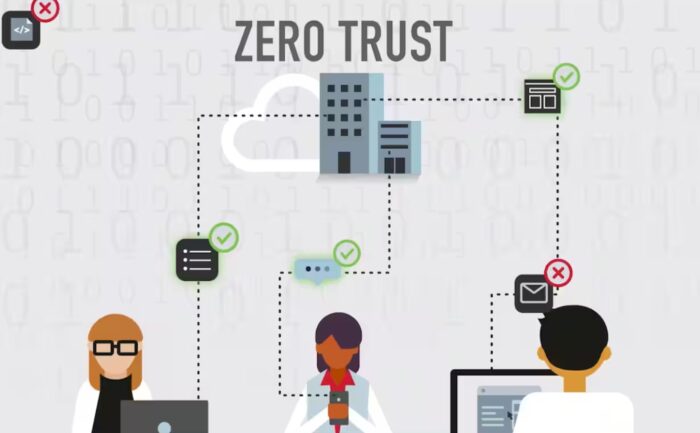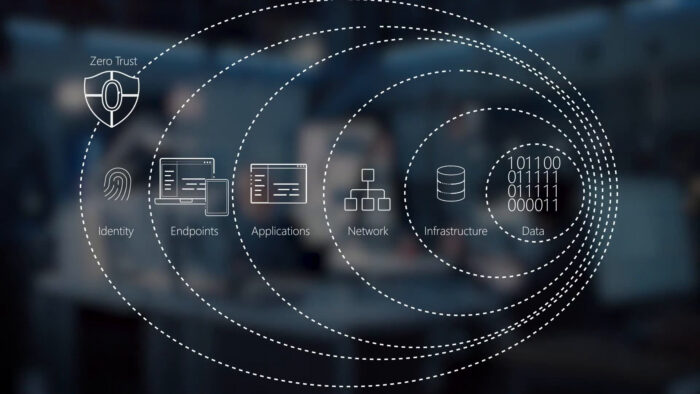
Organizations have a growing interest in understanding the concept of ‘Zero Trust Security’ and how it may be utilized to improve the security of their data and systems. A zero trust approach can protect any organization, small or big, in the new age of remote labor.
So, what precisely is zero trust security, and how does it work? In this piece, we’ll go over zero trust security and more.
What Exactly Is Zero Trust Security?
Zero trust security is not a specific product, provider, or technique.
Zero trust security is a methodology or framework for safeguarding data and applications inside an organization. It is based on a basic concept: “Trust no one; always verify.” It indicates that companies should not trust anything by default, whether within or outside their IT network or architecture. They must thoroughly check identities, authenticate, and approve individuals who are closer to the resources.
To execute this paradigm, firms must incorporate verification operations like auditing, tracking, monitoring, and alerting in all aspects of their IT architecture.
Zero trust security is comparable to the Principle of Least Privilege, in which privileged access is granted only to people who need it to do their jobs. The sole difference with zero trust security is that businesses must monitor all users’ activity, even the most privileged ones.
Don’t trust anybody, not even your most privileged users.

How Does Zero Trust Security Work?
In practice, a zero trust security approach focuses on five essential areas:
- Application
- Data
- Device
- Session
- User
The zero trust ecosystem prioritizes User and Device among the five priority areas. If we consider how corporations must approach cybersecurity, these decisions make a lot of sense. However, as the usage of cloud technologies grows, more areas that raise an organization’s risk surfaces have emerged. As a result, areas like data and applications have acquired relevance in the cloud-first approach (as mentioned above).
As a result, rather than focusing just on identity security, corporations have widened their security policies to include zero trust and tighter regulation of access.
What Are the Key Principles of Zero Trust?
By default, a zero-trust security paradigm views every person, device, and application as a possible danger to the enterprise. Access is allowed or refused only after a request’s authenticity has been assessed using role-based access controls (RBACs) and other contextual data such as the request origin, timestamp, and user behavior analytics.
The Zero Trust Extended Security Model identifies seven major concepts or areas of attention for organizations attempting to establish a zero trust security model.
Five of these concepts rely on implementing a “default deny” security stance on various company assets, including:

1. Zero Trust Data
Improved data security is one of the major goals of a zero-trust security strategy. To implement zero trust, you must first identify caches of sensitive or valuable data, map common data flows, and define access rules based on business objectives. These rules must also be uniformly set and implemented across an organization’s IT ecosystem, which includes desktops, mobile devices, application and database servers, and cloud deployments.
2. Zero Trust Workloads
Cloud-based workloads, such as containers, functions, and virtual machines (VMs), are appealing targets for hackers and need special security measures. Tailored, granular zero trust security monitoring and access control are critical for securing these assets, particularly in public clouds.
3. Zero Trust People
Compromised credentials are the top source of data breaches. Therefore, login and password authentication are no longer adequate. Zero trust requires robust authentication via multi-factor authentication (MFA) and zero trust network access.
4. Zero Trust Networks
Defending the traditional network perimeter is insufficient for corporate cybersecurity or zero-trust security policies. A zero-trust network is micro segmented, with perimeters created for each company’s key asset. Security inspections and access restrictions may be enforced at these borders, making it simpler to prevent lateral movement of threats via the network and contain and isolate a potential breach.
5. Zero Trust Devices
A zero-trust security policy treats all devices linked to the corporate network as untrustworthy and potentially dangerous. Implementing zero-trust security requires the capacity to identify potential threats and isolate compromised devices.
The other two core concepts explain the essential skills required for a zero-trust security approach, including:
- Automation and Orchestration: A zero-trust network can identify illegal and possibly dangerous actions in the business environment. The zero trust architecture must be linked with the corporate security infrastructure and IT architecture to enable fast, automated, scalable incident response, security audits, threat hunting, and work delegation.
- Visibility and Analytics: A zero-trust security strategy is focused on making informed access choices, which requires extensive visibility into the actions that occur on company devices and networks. Effective zero-trust security is built on analytics that continuously monitor, log, correlate, and analyze data throughout the corporate IT ecosystem.

Do You Need Zero-Trust Security?
Here are the advantages of establishing a zero-trust security architecture:
Reduces Risk for Organizations
A zero-trust solution assists enterprises in reducing risk in the cloud while improving governance and compliance. It enables them to obtain greater insight into all devices and users, identify risks, and retain control throughout the network. A zero-trust approach aids in developing rules that are automatically updated when fresh risks emerge.
Turns Down the Breach Chances
Data breaches not only cost businesses money, but they can also undermine consumer trust. Customers and governments are raising their expectations for security and data privacy, and it is up to businesses to satisfy those needs as effectively as feasible.
To decrease the probability of breaches, a network that employs the zero trust design regularly assesses the workload. When a mismatch is found, its communication rights are restricted to the rest of the system. This procedure continues until the stated security rules enhance the system.
Increases Compliance and Trust
Zero trust design automatically increases organizations’ hunger for compliance and regulation adherence. In turn, this allows them to build consumer trust. Several solutions are available from reputable vendors that provide cybersecurity services to organizations of all kinds to help make the digital world safer.

Conclusion
Zero trust security is more than just a slogan; it is a game-changing approach to cybersecurity that reflects the reality of today’s digital ecosystem. Organizations that follow zero trust principles and execute a comprehensive security policy may proactively fight against an ever-changing threat environment, protect sensitive data, and ensure the continuation of their operations. In an era when confidence must be gained constantly, zero-confidence security is the blueprint for a safer digital future.











